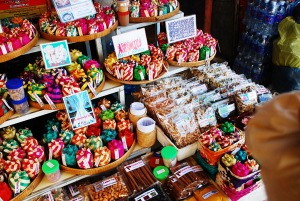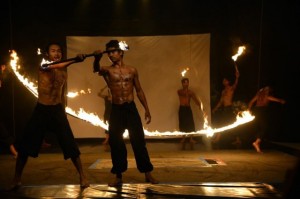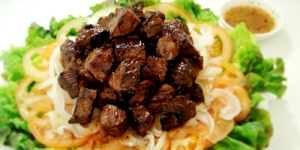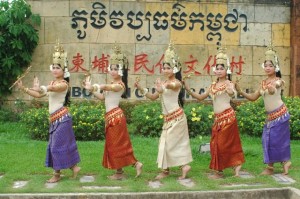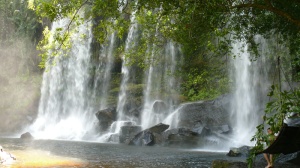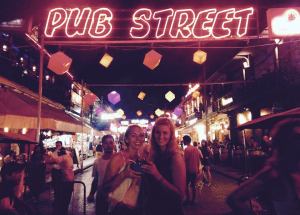1. Temple Tours: You can buy a 1 day ($20 USD) or 3 day ($40 USD) to explore Angkor Wat and the surrounding temples in Angkor, like Bayon (the temple of faces), Ta Prohm (Tomb Raider temple), and dozens of others. Do sunrise at Angkor Wat and sunset at Phnom Bakheng temple. I did the 3 day pass so that I didn’t feel overwhelmed, which is somewhere in the hundred if I remember correctly. You can get a tuk-tuk driver to take you on the big loop of temples for $15 or less, definitely not more. But besides these temples, you can also pop just outside of Siem Reap to the Rolous temples, a small town that predates Angkor Wat (10 to 15 from Siem Reap) or go to Beng Mealea and Koh Ker (45 minutes drive from Siem Reap) to see temples that are untouched by the reconstruction projects that have sculpted the other temples you will visit. You can climb all over and explore these ruins.
2. Floating Villages: There are three floating villages you can visit from Siem Reap on the Tonle Sap Lake (the largest freshwater lake in Southeast Asia and ecological hotspot for diversity and fishing, UNESCO biosphere since 1997); the first village, Chong Kneas, is very touristy and many people expressed disappointment visiting here, but I must say that you should remember that this is a village in a low income country; poverty runs rampid. I heard similar things about the second village called Kompong Phluk, but what is really attractive about this destination is the flooded mangrove forest that is magical to navigate through. Third village is very far north on the lake, Kompong Khleang, but is known for being the least touristy. In all three of these locations you can experience the daily life f the river peoples. I’d recommend going through Tara River Boats if you can budget it (they provide transportation and meals)
3. Shopping: Shop around the Old Market (Psaar Chaa) area for a bunch of tourist goods, handmade and not; there is a variety of restaurants and street vendors. After the sun goes down, and you find sweet relief, head over to the Night Market and enjoy the rich commodities and crafts from here as well.
4. Eat Bugs: I recommend eating bugs!! If you don’t want to eat any of the vendor silk worms or crickets that you can find in the Old Market, head over to Bugs Cafe for gourmet and delicious meals like a Bug Mac or Tarantula Doughnuts. They are actually very appetizing and fun dishes. 4.5 stars on Tripadvisor!
5. Give Back: There are a lot of really cool places you can visit that will enhance your trip culturally, as well as give back to the war ravaged and poverty stricken community that is still very much alive in Cambodia. I recommend the Cambodia Circus called Phare, which supports a school over over 1,000 students in the arts. They give an impressive and family friendly performance that reflects the history of Cambodia, with ACROBATICS! The Angkor Silk Farm also gives free tours that are fun and educational, and at the end you can buy products of their raw and fine silks; they are a little pricey but go to a good cause. They also stem from the Artisans of Angkor initiative, which has a separate workshop and shopping area in Siem Reap, as well with a variety of handicrafts that are made BEAUTIFULLY; from spices to art to soap to liquer.
6. Take some classes: Wayism Spiritual and Cultural Activities offers active meditation or mindful mediation, Khmer Thangka (Cambodian silk tapestry) making, silk scarf painting, and more, for reasonable prices. You can also take a Khmer cooking class at Tiger de Papier or various other locations and make tantalizing dishes like Lok Lak. Try out this recipe too!! (http://www.epicurious.com/recipes/member/views/cambodian-lok-lak-50012663)
7. Museums and Cultural Centers: Angkor National Museum, Cambodian Landmine Museum, War Museum, and Cambodian Cultural Village are all in Siem Reap city limits and have a lot of information about the history of Cambodia, from Khmer temples and Hinduism to the Vietnam War and up to the the genocide and military regimes that wreaked havoc on this beautiful and rich land. You can also go to the traditional Khmer dancing and cultural expose shows at Aspara Theater; they serve dinner and do 5 different traditional Khmer dances with ornate and fabulous costumes.
8. Embrace the Natural Beauty: Phnom Kulen National Park has spectacular sights, including the Phnom Kulen waterfall; there are two sections of the waterfall, where you can swim, as well as a nature trail, reclining Buddha statue and the carvings of the lingas, which have miraculously endured time and water flow. A picturesque place to visit. The Battambang Caves are worth a trip too, not far from town; they have modern temples, intricate caverns, and a memorial of bones and skulls for the children who were pushed into the deep holes during the Khmer Rouge Regime (The Killing Caves is another name).
9. Bar Crawl on Pub Street: Vibrant neon lights, cheap beer (50 cents a cup for draft, buy one get one free cocktails), delicious food (Mexican, Italian, Khmer galore); the Sky River Bar was doing a Full Moon Party when I went last, so ask around for the night life because its a lot of fun and there are a lot of foreigners and locals mixing up for a good time.
10. Adventure Tours: Ride quads through the jungles, zipline of the Flight of the Gibbon, go horseback riding; there is a plethora of things for you to do in the back woods of Cambodia that are adrenaline filled and exhilarating; most of these tours can be booked through your hotel or hostel and provide pick up and drop off. I found, as did my companions, that the tours are intimate and usually not over packed with people. You can also ride elephants, do river tours, thr world is your oyster.
Reflection: Cambodia was really different than Thailand, especially Northern Thailand. Cambodia is hot, humid, and definitely subject to abject poverty. Even in such a large city, you got the feeling that it was really rural. The vendors are more aggressive, but still bright and cheerful. Siem Reap is also a bubble; once you step outside the city, the poverty is even more striking. You can take a bus to Phnom Penh, the capital and the site of the Royal Residence, as well as the Killing Fields and Genocide Museum. Or you could go south of Siem Reap to Sihanoukville for the raw and untamed beaches; they are said to be as beautiful as Thai beaches, but before the flock of tourists.
The French influence is evident in Cambodia; you can visit the Old French Quarter to see some architecture; its worth a brief look. The city is very colorful and homes are vibrant pinks, greens, and yellows, like you are in the Bahamas. Being a former colony of France, the food has been influenced a little too; we had baguettes for breakfast and the “pancakes” are thin and eggy, remnant of crepes.
To be honest, I prefer Chiang Mai, Thailand for atmosphere and safety. Cambodia was my first look at how broken the nations are in Southeast Asia, after being colonized, ravaged by the Vietnam War, and rebuilding themselves; whereas Thailand remained neutral during the war and was never colonized. Its a sad comparison. In some ways, this is how I expected Thailand to be; I was surprised at how developed it really is.


